With summer vacations approaching, traveling with family is a popular activity. For the adventurous family who is contemplating or deciding to take an international trip, this post is for you! Last year we traveled with our young family of 5 to Brazil where we stayed for 1 month.
We visited 5 different international airports, visited and toured 5 large cities, and rented a car in 3 of those cities so we could drive to smaller towns. We had so much fun and not once did we feel unsafe, or have any dangerous or worrisome incidents. It was a beautiful and unforgettable experience, but we prepared A LOT in advance, and we were given some invaluable advice and tips from friends and family who live there.
So, since today marks 1 year since we arrived in Brazil, I thought I’d share a recap of sorts with some of my best advice as well as some pictures I never shared.
If you missed my post last year about our adventures in Rio de Janeiro, click here.
1. Print a full trip itinerary for each kid, with emergency contact info.
Having an itinerary of airport stops, with dates, times, connections, and confirmation numbers, of the entire trip for each child was so helpful. Instead of them asking me questions like, ‘where are we going’ and ‘what time will we get there’, they looked at their itinerary. It was also nice when I couldn’t use my cell phone but I needed a flight number or phone number. This also gave me a bit of peace of mind— if anything happened, each of them would have some important information– knowing emergency contact info of someone local, including addresses of wherever we were staying.
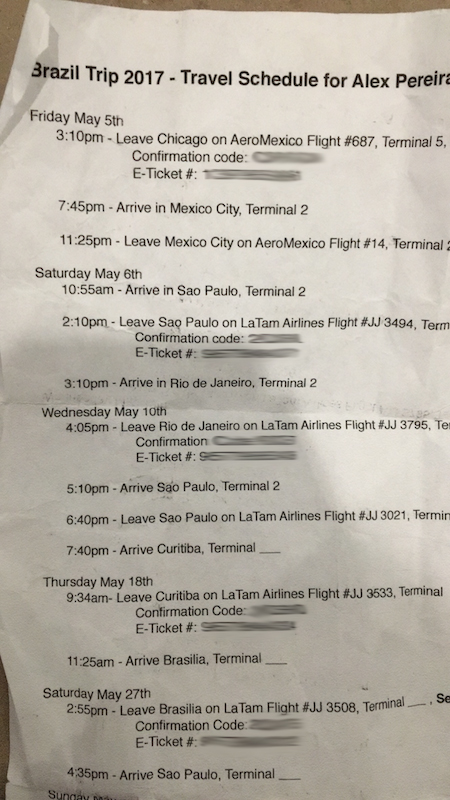
One of the kids’ itineraries that stayed in their pocket or backpack.
2. Pack each kid their own backpack for flights. And wear comfy layered clothes.
Things we packed in each backpack:
– change of clothes (underwear, shorts, t-shirt, socks in gallon ziplock bag)
– headphones
– thin blanket
– neck pillow
– book(s)
– journal/scrapbook/drawing pad
– bop-it, fidget spinner, bouncy ball/hacky sack
– energy bars
– snack money — $5-10
– an electronic device (leave at the hotel or wherever you are staying)
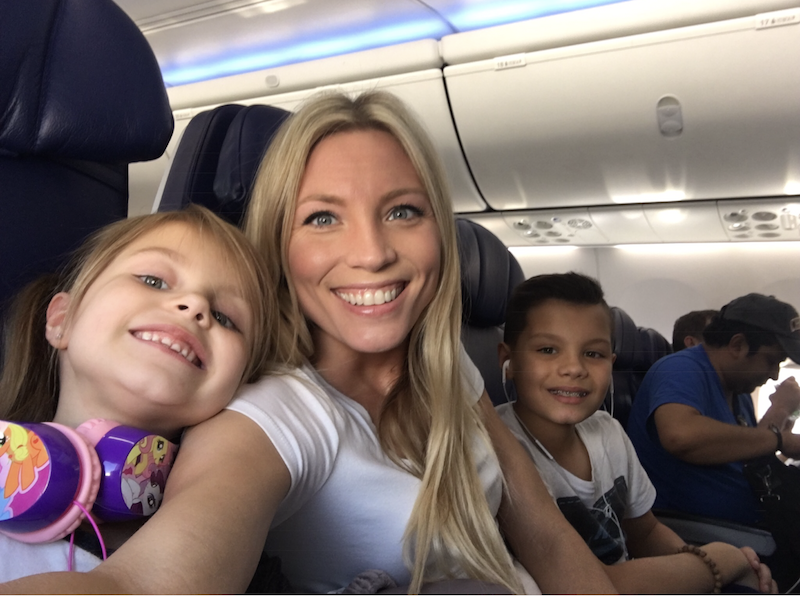
To avoid arguments, I positioned myself between two of my kids. Each had their own set of headphones and kept busy during the flight with movies, videos, and music.
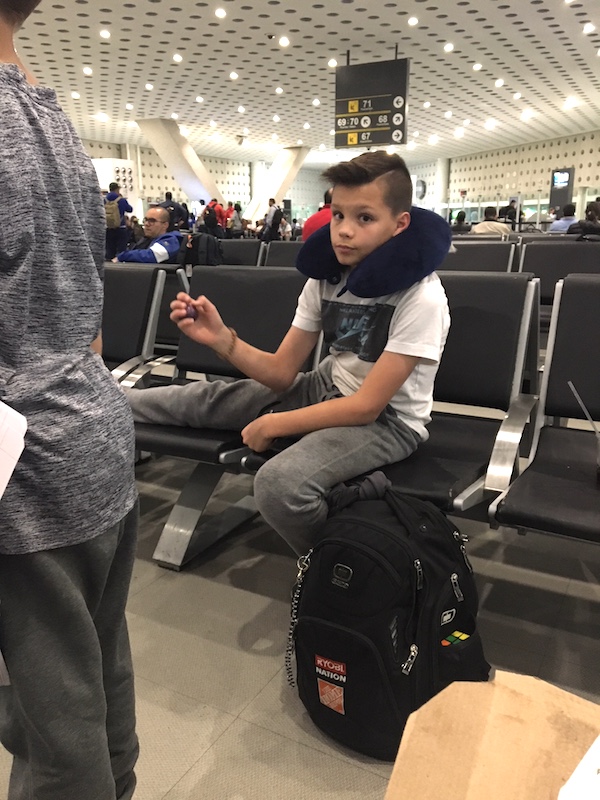
Owen, my oldest, waiting in the Mexico City airport with his neck pillow and backpack, while playing with a bouncy ball.
3. Get pay-as-you-go cell phone service or an international plan.
If you plan on spending more than 2 weeks in a single foreign country, and you have family/good friends with a local, I would recommend going with them to a local cell phone carrier and getting a pre-paid SIM card for your unlocked phone. This is primarily so you will have data and can use GPS and WhatsApp. In a pickle, you could make a phone call. Save social media updates for places that have wi-fi, so you aren’t tempted to constantly have your phone out. If you don’t know anyone locally, or the trip is less than 2 weeks, another great option is to sign up for your U.S.-based carrier’s international plan. They are typically more expensive than getting a local SIM card, but it’s around $10 extra per day to use your regular plan internationally.
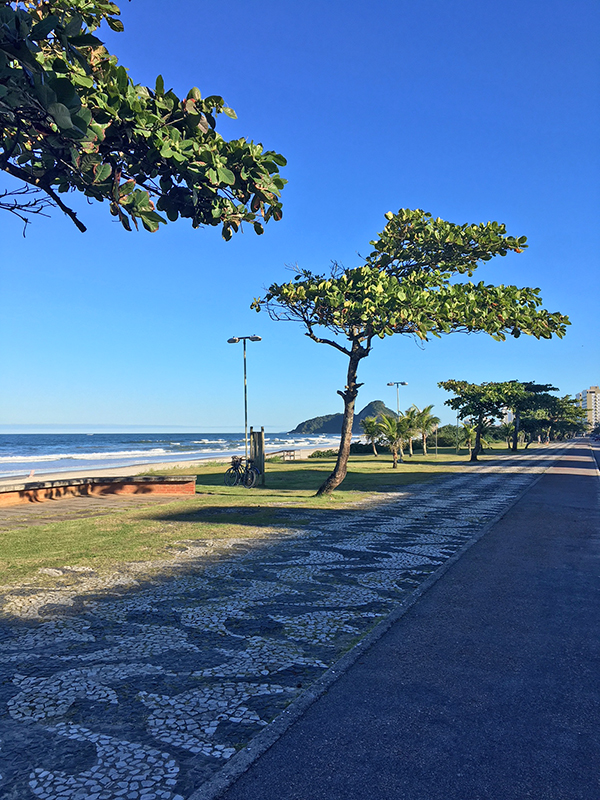
Praia em Matinhos, Paraná. We drove from Curitiba, to Morretes, to Matinhos, spend a couple hours at the beach and drove back to Curitiba, all in 1 day.
In Brazil, people use WhatsApp more than they use text messages or phone calls, because you can call or send messages within the app and it only uses internet data– no SMS or minutes usage. We communicated with everyone — friends and family using WhatsApp.
Additionally, it was our life-saver wherever we went. We rented a car, so it was especially useful, but even if we relied on other means of transportation, walking around anywhere can get confusing, so GPS will be your best friend.
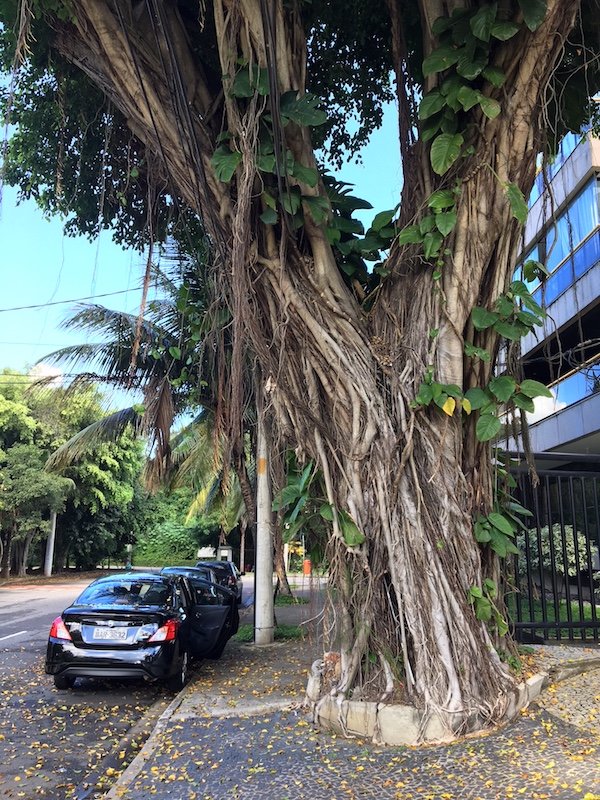
Our black coupe (with the door open) was our rental car in Rio de Janeiro. When in Rio, we were told to stay away from Linha Amarela (main highway that goes through several sketchy “favelas”), and stick to the prettier coastal highways.
One thing about cell phones— while it isn’t likely, they are an easy target to get stolen. We wanted to be cautious, so we never walked around with our cell phone in our hand, as I normally would here in my suburban small community. If I needed to check something or take a picture, I pulled it out, did so quickly, and put it away. You will notice, as I did, that most everyone is on their phones (just like in the U.S.) but they have the advantage of being a local and being a lot more street savvy than you. 😉
4. Teach your kids some short local phrases/greetings in the national language.
For example, we taught our kids to call us “mamãe” and “papai” (‘mom’ and ‘dad’ in Portuguese), and how to say “oi” (hi), “por favor” (please), “obrigado/a” (thank you – “o” ending if a boy is saying it and “a” ending if a girl), “de nada” (your welcome), “nossa!” (wow!), “olha!” (look!), “tudo bem?” (how are you?), and “cadê…” (where is…). Not only is this good for kids to learn for manners if they go anywhere (getting in the habit of saying please and thank you), but trying to speak even small words in Portuguese helped us draw a little less attention to ourselves.
We consistently reminded our kids that if they needed to talk to us, to come close and whisper or speak quietly (my kids are loud by default so this was necessary). We already stood out (at least my daughter and I did with our blonde hair), but I’m a big fan of blending-in in any way possible in a foreign country. I wanted to avoid people looking at us because my kid just shouted something in English, so these phrases ended up being a great way to blend in a little.

Walking up the stairs to the backside of Cristo Redentor. The train drops you off just below the stairs and there are several gift shops before you get to the top.
If you have the opportunity to take a language lesson from a native speaker before your trip, they will teach you the correct pronunciation and practice additional, useful phrases so you don’t feel so dependent on other bilingual speakers when out in public places. Check a community college, craigslist, or the bulletin board at an international supermarket.
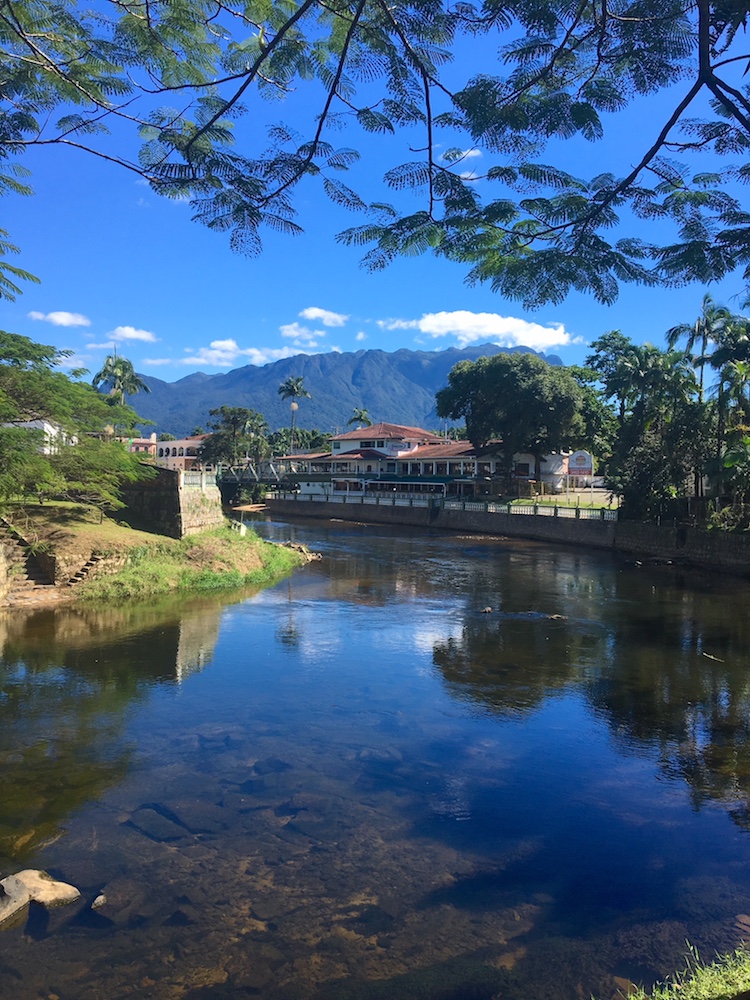
Rio Nhundiaquara, Morretes, Paraná
5. Wear sandals and minimal accessories whenever possible.
Our footwear of choice was normally flip-flops in areas where it was warm. It was easy to slip on and off, especially if we made a quick trip to the beach, and if they got lost for any reason, it was an inexpensive replacement. Going back to calling less attention to ourselves, we found it best to wear cheap or minimal jewelry or accessories. Nothing flashy or of high-value. In a worst-case scenario, I didn’t want to take a change and lose anything that was expensive or valuable. I found that it eased my anxiety to plan for unlikely but possible scenarios.
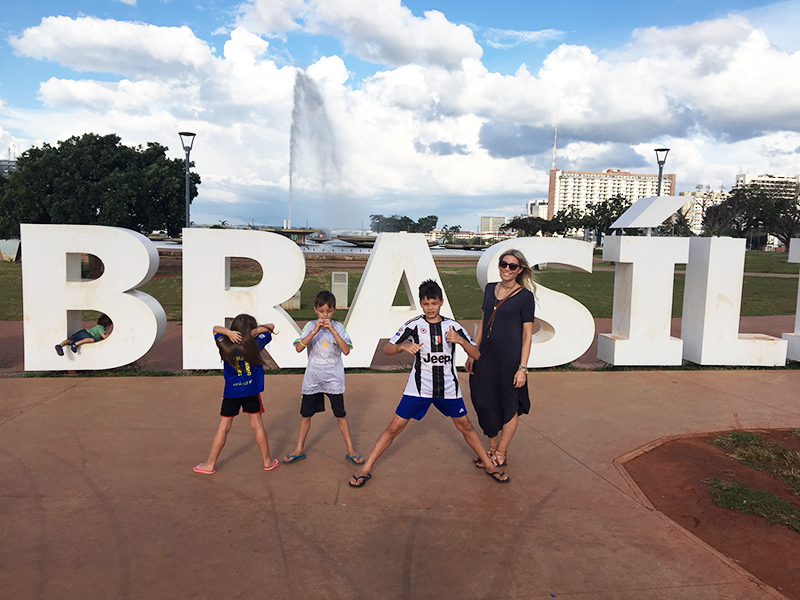
Typical attire while we toured downtown Brasília, the capital, in front of the Brasília TV Tower.
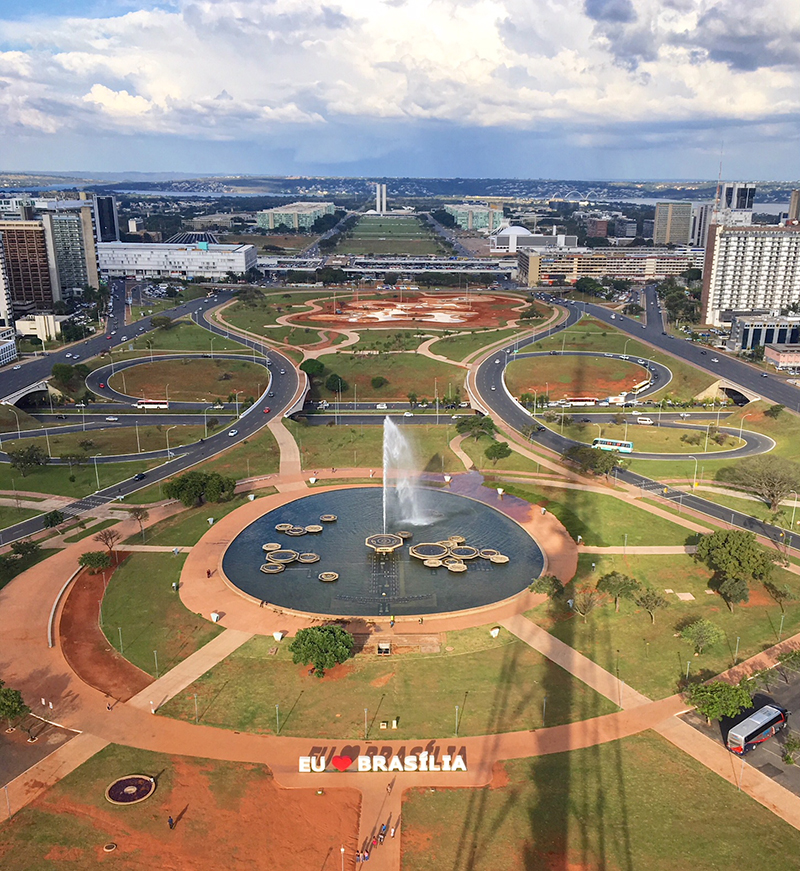
View from of the top of the Brasília TV Tower. The city was designed by Lúcio Costa with the help of Oscar Niemeyer to be the shape of an airplane, which is most visible from this high vantage point. In the distance you can see two towers of National Congress and just beyond to that is the Palácio do Planalto, the President’s Palace.
6. If using a purse, use a non-brand, cross-body with a zipper.
Leave your name-brand, fancy, flashy purse at home. Go to Target and find a cute, small-ish cross-body purse with a zipper closure. Even better if there is a zipper and a fold-over flap! Purses are so easy to rob, no matter what big city you are in, and typically a cross body one with a zipper are more difficult to steal.

In the Rio de Janeiro airport getting ready to fly to Curitiba. This small cross-body purse, I got at Target was very very comfortable and the perfect size.
I liked one that was small-to-medium in size because it could hold all our passports and tickets when traveling in the airports, but on a daily basis I could also just keep what I needed for the day in it– a small bottle of water, a small wallet, chapstick, and a small first aid kit (with advil, tylenol, tums, some cleansing pads, bandaids, and first aid ointment).
7. In big cities, stay in tourist locations unless accompanied by a local resident.
Tourist hot spots are typically safer because there are more people like yourselves (foreigners) and more police close by. It doesn’t mean you have to stay where the biggest crowds are, but you will stand out less if you stick to places where tourists are expected. That being said, some of our most memorable experiences were made doing things off the beaten path, which we felt comfortable doing because we knew locals.
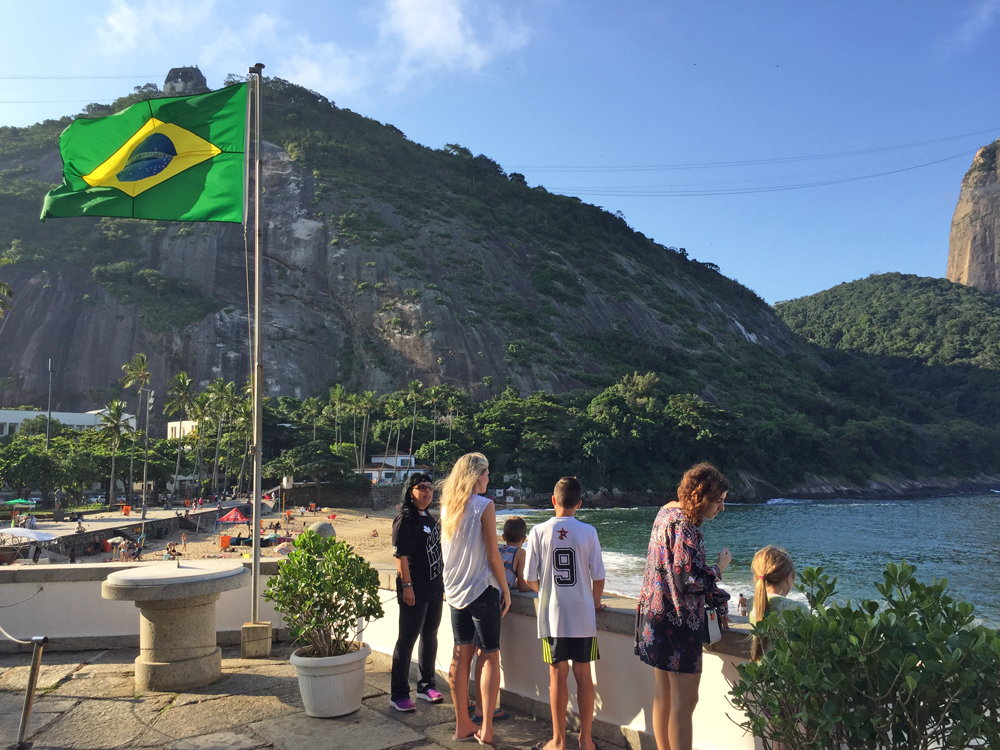
At the entrance of Terra Brasilis, a lesser-known and delicious restaurant on Praia Vermelha, right next to the Sugarloaf Mountains (Pão de Açucar).
Even though my husband was born and raised in Brazil, and blends in well, its been a long time since he lived there. It was nice having family tell us the safest routes and places to visit. You will definitely have a more unique experience if you can make a connection with a local who you trust (reach out to a friend, make friends), and have them show you some family-friendly activities.
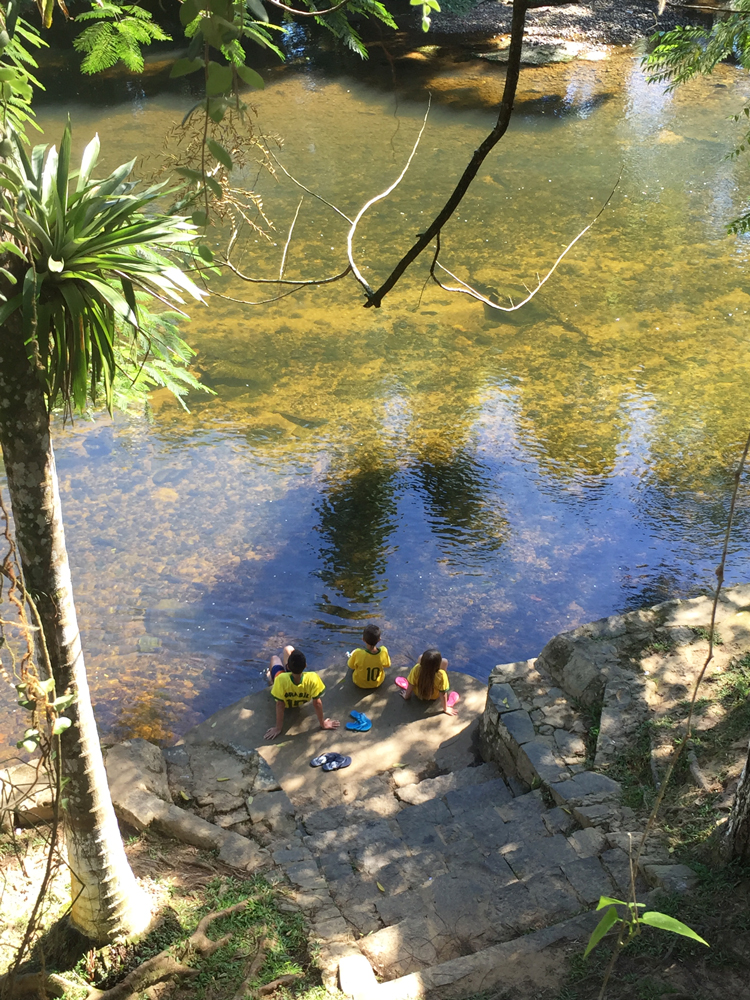
My kids wading their feet in Rio Nhundioquara, below the Restaurant Casa do Rio in Morretes, Paraná (about a 1.5 hour drive outside of Curitiba).

Alex, horseback riding for the first time, with his great uncle Jarbas, at a ranch just outside of Curitiba.
8. Bring your own (thin) beach towels.
Beach towels can end up being more expensive depending on what you are able to find them, so we opted to bring thin ones that were super cheap here in the States. Because we planned on going to the beach pretty often, it was so nice to be able to head there at a moment’s notice and not have to worry about finding our towels. The day before we flew back home, we just threw them away the day, as they had served their purpose, and souvenirs took their place in our bags.
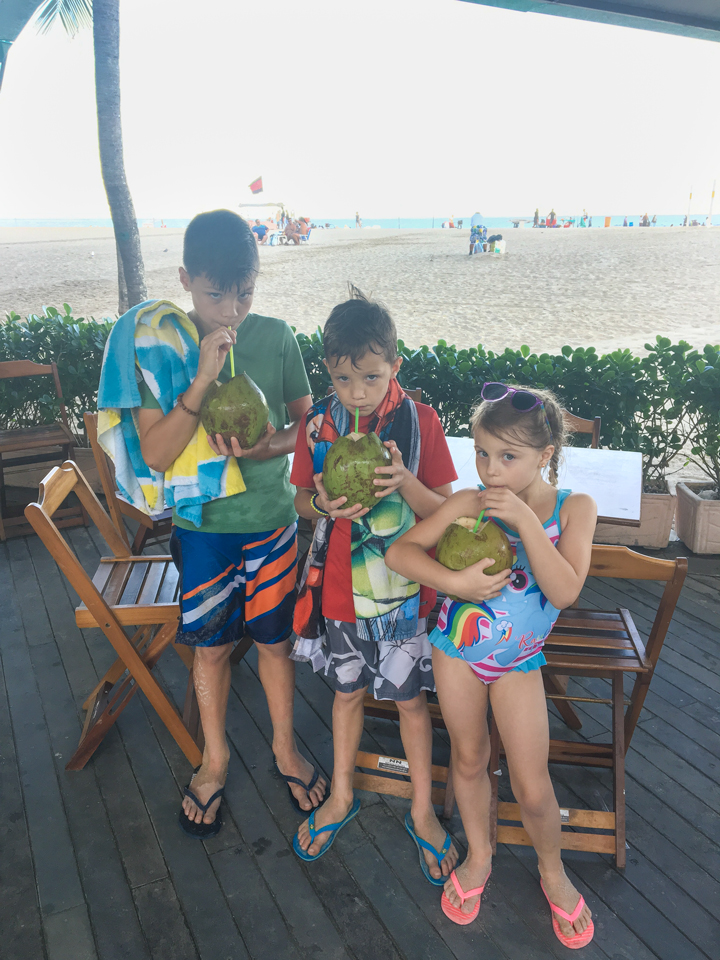
On Copacabana Beach in Rio de Janeiro, trying fresh coconut water for the first time. The thin towels we brought are hanging around their necks.
9. Eat like a local but don’t drink tap water.
Plan to have a more authentic experience by not trying to find cereal or traditional snacks and meals that you are ‘used to’. Instead, wake up early and walk to the corner bakery (“paderia”) to buy some fresh-made bread, cheese, fruit and juice. Our favorites breakfast was “pão francês” (small french bread) or “pão de queijo” (cheese bread), and some bottles of juice (‘caju’ is my favorite). Brazil is a great place for kids to try new foods because most things are NOT spicy. Crowd-pleasers include: pao de queijo, feijoada, pastel, coxinhas, pamonha, canjica, stroganoff, Portuguese pizza, and of course Brazilian churrasco (barbecue). To see more of my Brazilian food recommendations go to this post.
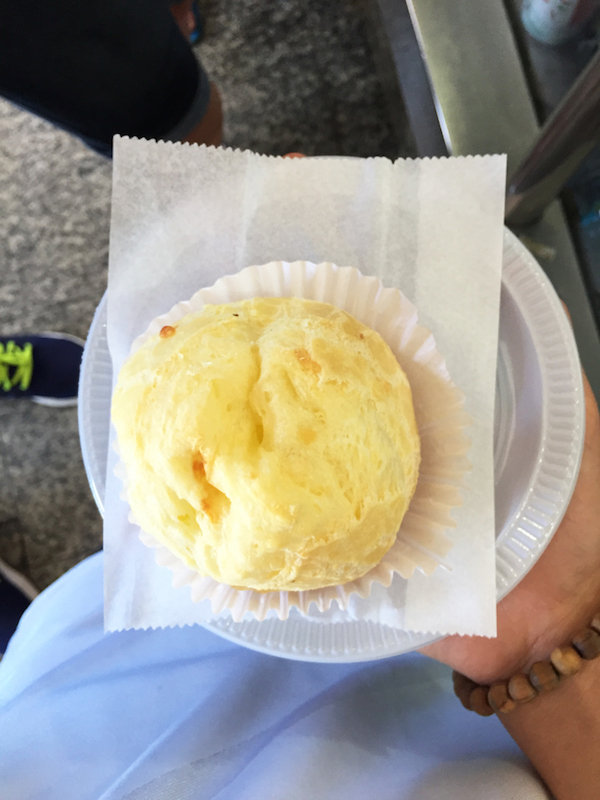
A large cheese bread roll (pão de queijo) bought at a bakery.

Typical breakfast: fresh fruit, bread with cream cheese (requeijão), ham, melted cheese, and a cup of cashew juice.
Go to the grocery store and find the vast selection of yogurts to try (in Brazil their yogurt is typically thinner consistency, unless it’s greek), or fresh fruit. Did you know there are 6 different varieties of mangos that grow in Brazil? As long as you remember to buy bottled water wherever you go (in case their tap water isn’t filtered), it’s very unlikely you will get sick.
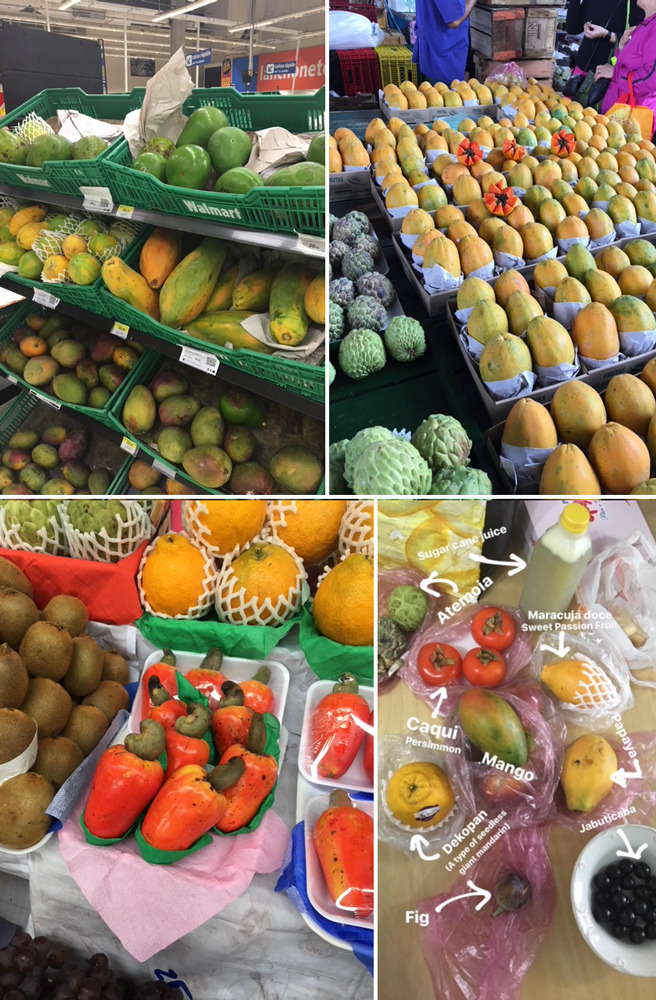
Papaya, guava, mangoes, kiwi, cashew fruit, and lots of other local-to-Brazil fruits found at the grocery store and markets.

Spread of food (Barreado – a local dish, and seafood) in the restaurant, Casa do Rio, in Morretes, Paraná.
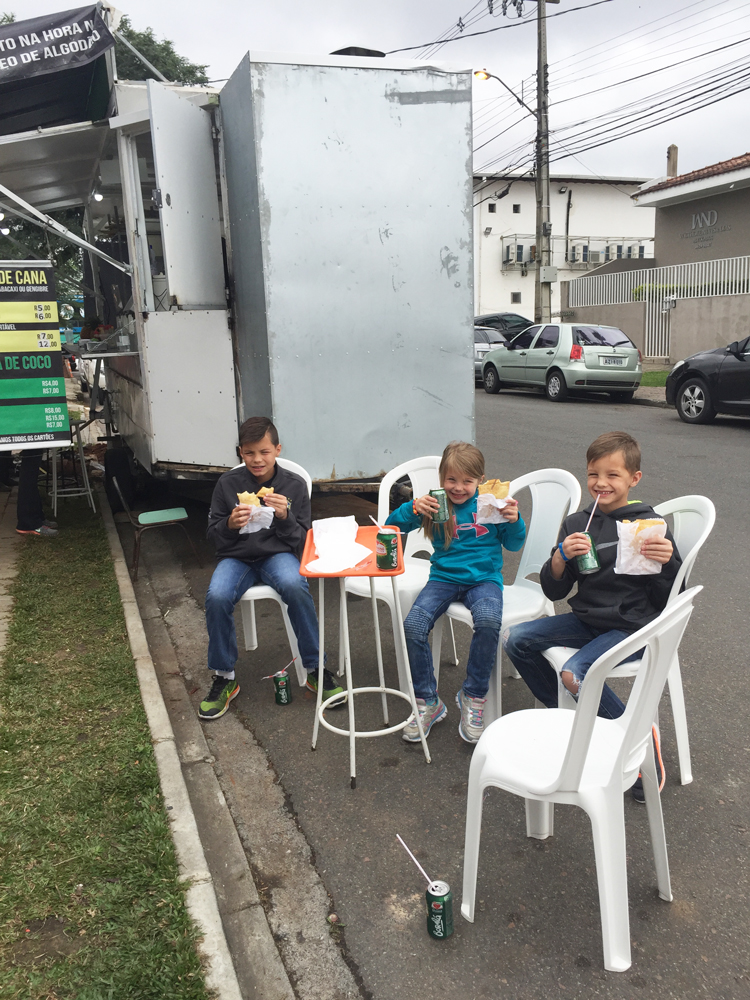
Eating ‘pastel’ from a food truck in Curitiba.
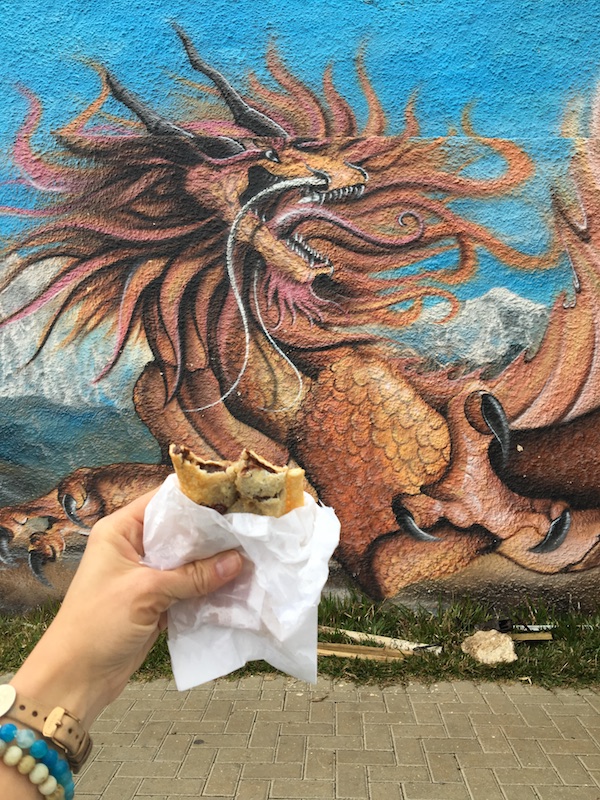
Banana with nutella pastel in front of some street art.

Traditional lunch of rice, beans, sausage, and salad. I got this at the food court in a mall for $5.
10. Plan to visit at least one park per city you visit. Buy a soccer ball and allow them to run and play with some extra freedom (within eye-shot).
Kids need to get some energy out and release the tension of travel, a foreign language, unfamiliar surroundings etc. Those things will wear on both their and your resiliency and patience, so parks are a great way to give them the opportunity for them to run, play, and have fun, all for free. We made sure to visit a park or a beach almost every day we were in Brazil, and we all felt a little more relaxed and renewed by doing so.
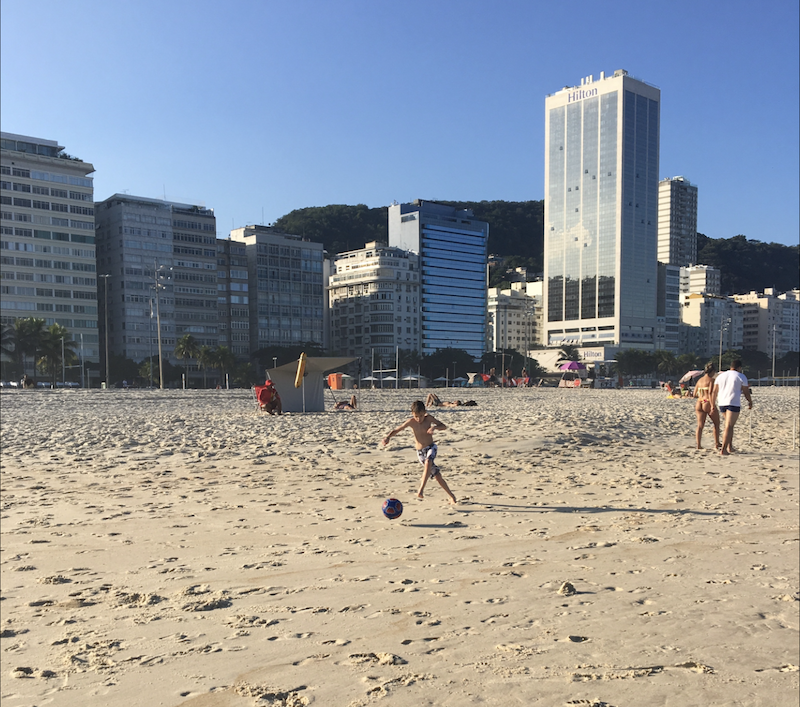
My middle son, Alex, playing soccer on Copacabana Beach, in Rio de Janeiro.
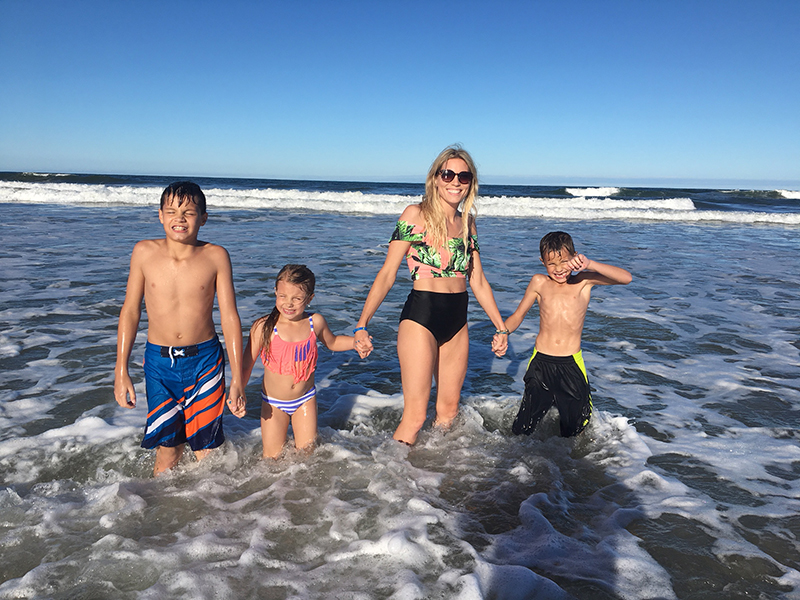
At the beach in Matinhos, Paraná.

Visiting Tanguá Park in Curitiba. One of the prettiest parks we visited. Curitiba has a lot of beautiful, large, well-maintained parks.
Inexpensively, we also visited a few museums, which was a great way for them to see a different aspect of the culture.
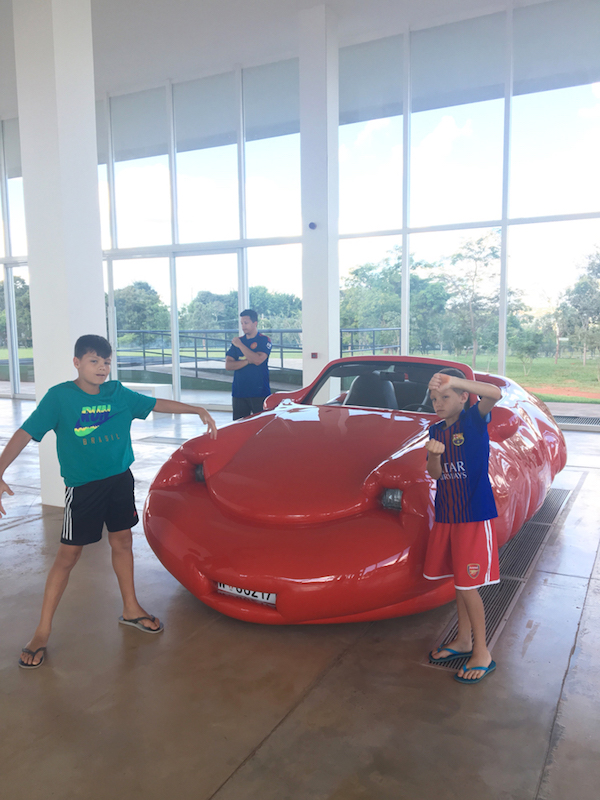
Boys in front of an surrealist exhibit in a museum in Brasília.
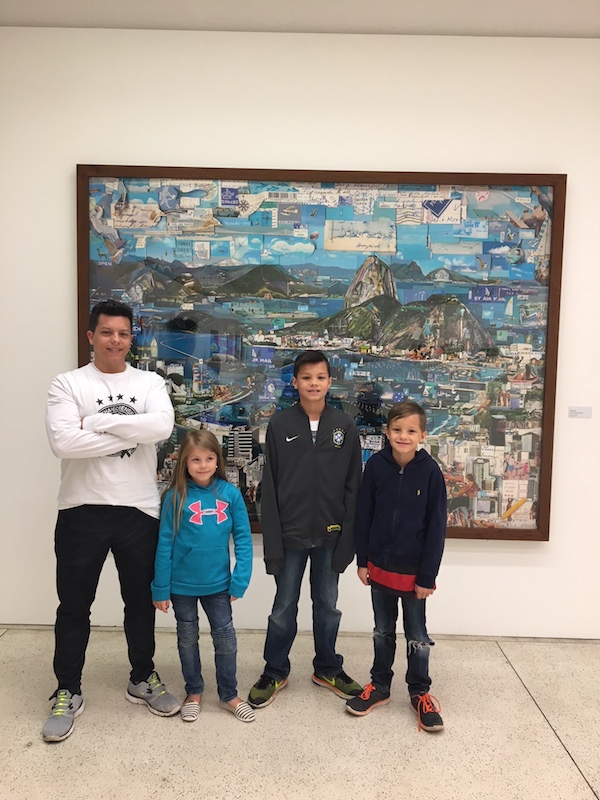
At the Oscar Niemeyer Museum in Curitiba.
If you get the opportunity to visit a waterpark, always capitalize on that! 😉
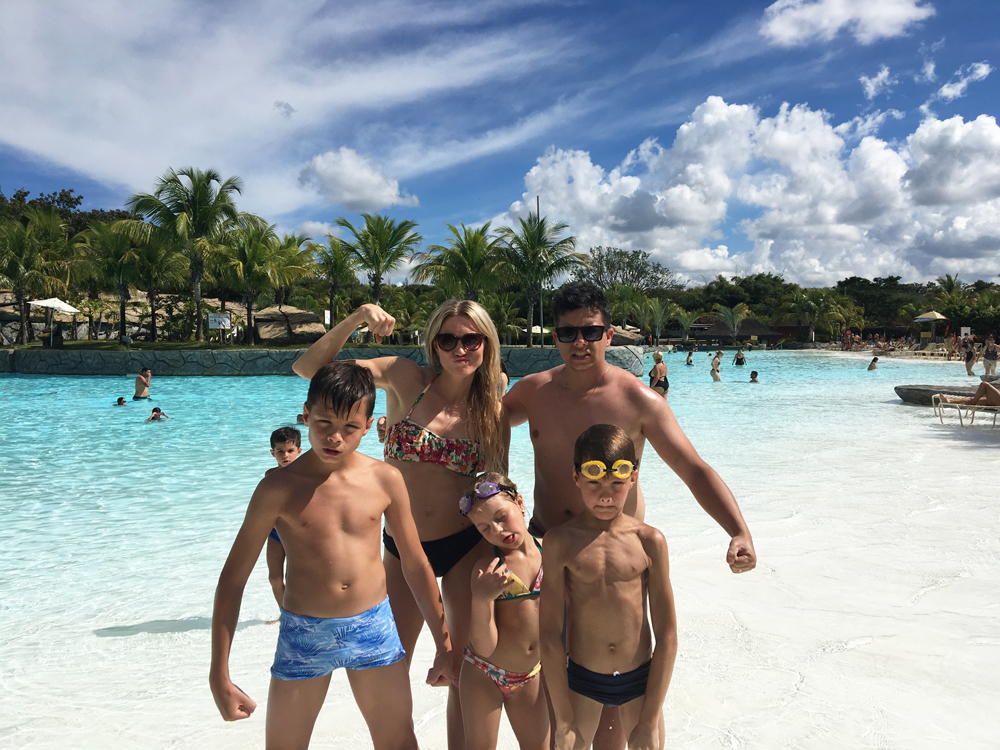
At Rio Quente Parque Aquático in Caldas Novas, Goiás.
Oh and buy your boys speedos! haha! They actually blend in better with speedos than they would have with swim shorts.
Bonus Tip on Health/Medicine Prep
Before we traveled, we made sure we had all the necessary vaccinations (many parts of Brazil require a Yellow Fever vaccine and some parts are at risk for Malaria for which we got medicine before-hand), asthma medications for my daughter (just in case, although we didn’t use it), and a good first aid kid with medicines they are familiar with and can take. Over-the-counter medications can and often are different in other countries and you could have an allergic reaction if you take something unfamiliar. Owen (our oldest) started to get a swimmer’s ear infection and took an over-the-counter antibiotic that is commonly used for ear infections that was recommended by family. He ended up having an an allergic reaction (got hives on his face and neck), and fortunately the ear infection cleared up on it’s own in a couple days.
If you enjoyed this post, found it helpful or know someone who might find it helpful, please share it and comment below!
Obrigada! Até mais!
Rachel
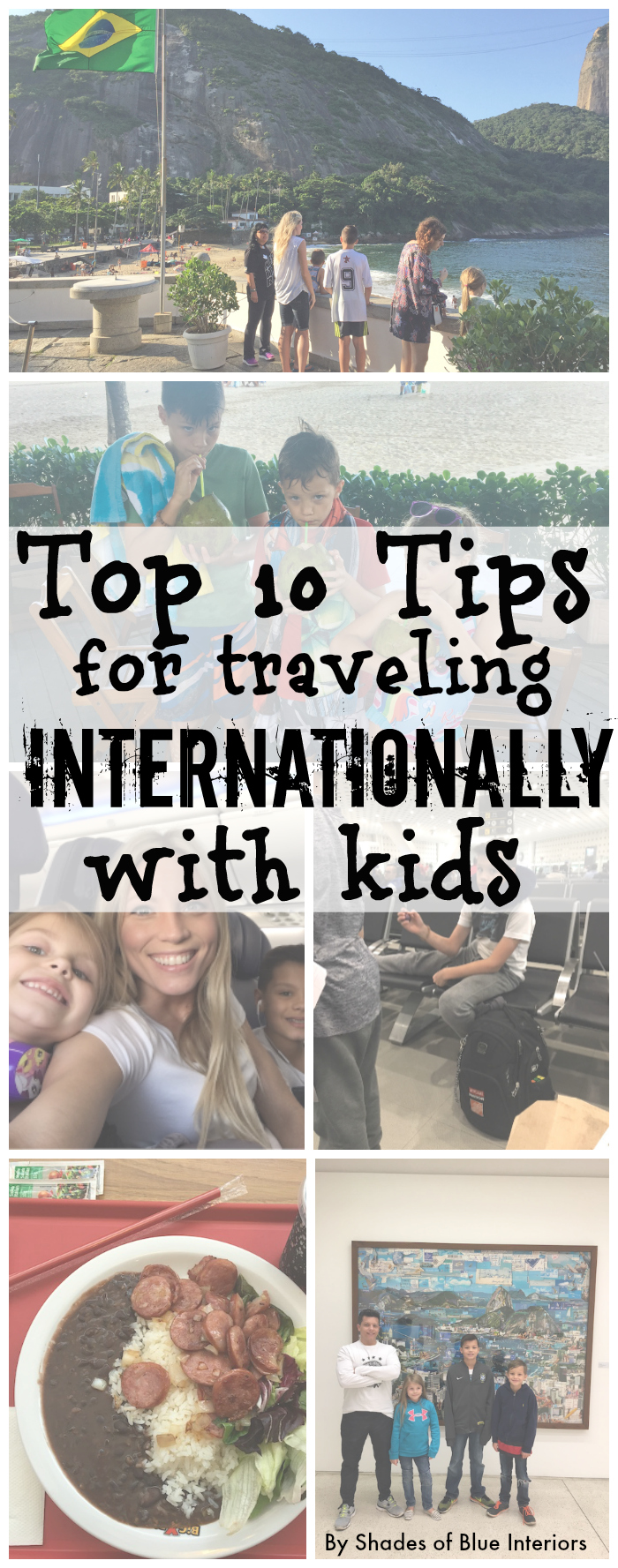
Love your post!! We took the same precautions when my family and I went to Peru. We had no problems at all. We enjoyed the fresh fruit and fresh bread every morning. Food was delicious!! Thanks for sharing your tips!!
Thank you for the excellent travelogue and tips!
Nice post. Thanks for sharing these great tips, I will consider all your tips for our upcoming Europe trip with my family and kids. Keep sharing such helpful tips.
there are tips and tricks to making travel fun and exciting for family members of all . Many thanks!